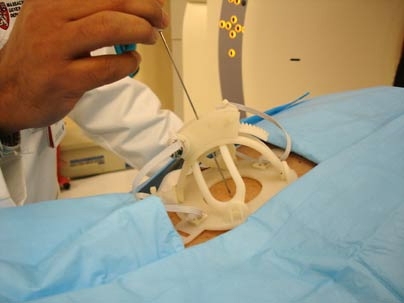Two MIT graduate students have helped design a machine that may make needle biopsies less invasive and less prone to complications for lung cancer patients.
Working with Professor of Mechanical Engineering Alexander Slocum and Massachusetts General Hospital radiologist Rajiv Gupta, MIT mechanical engineering graduate students Conor Walsh and Nevan Hanumara, along with graduate student Steven Barrett of the University of Cambridge, have come up with a machine they call Robopsy -- a lightweight, plastic, dome-shaped device that holds a biopsy needle and can sit on a patient's chest during a CT scan.
The team hopes the invention will cut both time and complications from a typical lung biopsy.
Currently, doctors use a CT scan to find a suspect mass in a patient -- but they cannot be in the room during the scan because the scan uses radiation. They therefore watch the scan through a computer monitor and then return to the room to find the right spot for the biopsy manually. The process can be very complicated and may require more than one puncture.
"We are trying to make it just one poke," Walsh said.
Although patients are anesthetized locally, the current process can cause pain and complications and can require a hospital stay.
Robopsy would allow doctors looking at the CT scan to use a laptop to control the movement of the biopsy needle, allowing more control. Hanumara and Walsh said they are considering installing a joystick for easier manipulation.
The advantages of Robopsy over the current method of biopsy are threefold, said Hanumara. It has the capacity to hit smaller lesions; it could decrease complications; and it may eliminate the need for overnight hospital stays, he said.
Robopsy will be made of recyclable plastic, said Hanumara, who called it "reliable, disposable and inexpensive."
Hanumara and Walsh said their device is not limited to use for lung biopsies and may be used someday for other kinds of cancer biopsies. Thus far, they have tested the device in a number of ways, including using it on turkey carcasses. They will begin testing Robopsy on live animals in August. They are working toward FDA approval.
"It is a new idea, something no one else is working on," Walsh said. In fact, the group's innovation has won a fair amount of recognition.
Robopsy earned a $5,000 Boeing Prize at the 2005 MIT IDEAS Competition. Last month, their invention received third place and a cash prize in the Biomedical Engineering Innovation, Design and Entrepreneurship Award competition, which is sponsored by the National Collegiate Inventors and Innovators Alliance, based in Hadley, Mass.
The students' work has been impressive, Gupta said. "The students were tremendous in moving this project from concept to actual working hardware," he said. "They came to MGH multiple times to see how lung biopsies are done, learn the mechanics of the procedure, and then incorporate (what they learned) in the Robopsy prototype."






